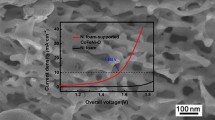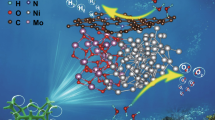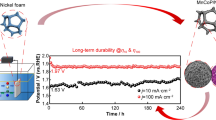Abstract
Exploring and designing bi-functional catalysts with earth-abundant elements that can work well for both hydrogen evolution reaction (HER) and oxygen evolution reaction (OER) in alkaline medium are of significance for producing clean fuel to relieve energy and environment crisis. Here, a novel Ni/NiO monolithic electrode was developed by a facile and cost-effective acid promoted activation of Ni foam. After the treatment, this obtained monolithic electrode with a layer of NiO on its surface demonstrates rough and sheet-like morphology, which not only possesses larger accessible surface area but also provides more reactive active sites. Compared with powder catalysts, this monolithic electrode can achieve intimate contact between the electrocatalyst and the current collector, which will alleviate the problem of pulverization and enable the stable function of the electrode. It can be served as an efficient bi-functional electrocatalyst with an overpotential of 160 mV for HER and 290 mV for OER to produce current densities of 10 mA cm−2 in the alkaline medium. And it maintains benign stability after 5,000 cycles, which rivals many recent reported noble-metal free catalysts in 1.0 mol L−1 KOH solution. Attributed to the easy, scalable methodology and high catalytic efficiency, this work not only offers a promising monolithic catalyst but also inspires us to exploit other inexpensive, highly efficient and self-standing noble metalfree electrocatalysts for scale-up electrochemical water-splitting technology.
摘要
开发和制备碱性条件下的非贵金属析氢和析氧催化剂对于缓解能源和环境危机至关重要. 本文利用一种简单的酸活化方法, 制备出了一种基于泡沬镍的镍/氧化镍一体化电极. 由于其粗糙及类片层的表面结构使得制备出的电极具有大的比表面积和更多的表面反应活性位点. 同时, 与粉末催化剂相比, 此一体化电极可实现催化剂和集流体之间的良好接触, 在一定程度上缓解催化剂的脱落问题, 保证了电极的稳定性. 当用作双功能催化剂时, 其表现出了优异的催化活性和良好的稳定性. 此法简单且易规模化, 可以为制备其他非贵金属催化剂提供思路.
Similar content being viewed by others
References
Turner JA. Sustainable hydrogen production. Science, 2004, 305: 972–974
Dresselhaus MS, Thomas IL. Alternative energy technologies. Nature, 2001, 414: 332–337
Gray HB. Powering the planet with solar fuel. Nat Chem, 2009, 1: 7–7
Lewis NS, Nocera DG. Powering the planet: chemical challenges in solar energy utilization. Proc Natl Acad Sci USA, 2006, 103: 15729–15735
Jiao Y, Zheng Y, Jaroniec M, et al. Design of electrocatalysts for oxygen- and hydrogen-involving energy conversion reactions. Chem Soc Rev, 2015, 44: 2060–2086
Zheng Y, Jiao Y, Zhu Y, et al. Hydrogen evolution by a metal-free electrocatalyst. Nat Commun, 2014, 5: 3783
Lu S, Zhuang Z. Electrocatalysts for hydrogen oxidation and evolution reactions. Sci China Mater, 2016, 59: 217–238
Chen WF, Sasaki K, Ma C, et al. Hydrogen-evolution catalysts based on non-noble metal nickel-molybdenum nitride nanosheets. Angew Chem Int Ed, 2012, 51: 6131–6135
Ledendecker M, Krick Calderón S, Papp C, et al. The synthesis of nanostructured Ni5P4 films and their use as a non-noble bifunctional electrocatalyst for full water splitting. Angew Chem Int Ed, 2015, 54: 12361–12365
Gong M, Zhou W, Tsai MC, et al. Nanoscale nickel oxide/nickel heterostructures for active hydrogen evolution electrocatalysis. Nat Commun, 2014, 5: 4695
Yang Y, Xu X, Wang X. Synthesis of Mo-based nanostructures from organic-inorganic hybrid with enhanced electrochemical for water splitting. Sci China Mater, 2015, 58: 775–784
Dou S, Tao L, Huo J, et al. Etched and doped Co9S8/graphene hybrid for oxygen electrocatalysis. Energ Environ Sci, 2016, 9: 1320–1326
Cabán-Acevedo M, Stone ML, Schmidt JR, et al. Efficient hydrogen evolution catalysis using ternary pyrite-type cobalt phosphosulphide. Nat Mater, 2015, 14: 1245–1251
Wu Z, Guo J, Wang J, et al. Hierarchically porous electrocatalyst with vertically aligned defect-rich CoMoS nanosheets for the hydrogen evolution reaction in an alkaline medium. ACS Appl Mater Interfaces, 2017, 9: 5288–5294
Zhang Y, Ouyang B, Xu J, et al. 3D porous hierarchical nickelmolybdenum nitrides synthesized by RF plasma as highly active and stable hydrogen-evolution-reaction electrocatalysts. Adv Energ Mater, 2016, 6: 1600221
Ma TY, Dai S, Jaroniec M, et al. Metal–organic framework derived hybrid Co3O4-carbon porous nanowire arrays as reversible oxygen evolution electrodes. J Am Chem Soc, 2014, 136: 13925–13931
Liu Q, Tian J, Cui W, et al. Carbon nanotubes decorated with CoP nanocrystals: a highly active non-noble-metal nanohybrid electrocatalyst for hydrogen evolution. Angew Chem Int Ed, 2014, 53: 6710–6714
Bao J, Zhang X, Fan B, et al. Ultrathin spinel-structured nanosheets rich in oxygen deficiencies for enhanced electrocatalytic water oxidation. Angew Chem Int Ed, 2015, 54: 7399–7404
Zhu YP, Liu YP, Ren TZ, et al. Self-supported cobalt phosphide mesoporous nanorod arrays: a flexible and bifunctional electrode for highly active electrocatalytic water reduction and oxidation. Adv Funct Mater, 2015, 25: 7337–7347
Yan Y, Xia BY, Ge X, et al. A flexible electrode based on iron phosphide nanotubes for overall water splitting. Chem Eur J, 2015, 21: 18062–18067
Gao X, Zhang H, Li Q, et al. Hierarchical NiCo2O4 hollow microcuboids as bifunctional electrocatalysts for overall water-splitting. Angew Chem Int Ed, 2016, 55: 6290–6294
Wang C, Jiang J, Ding T, et al. Monodisperse ternary NiCoP nanostructures as a bifunctional electrocatalyst for both hydrogen and oxygen evolution reactions with excellent performance. Adv Mater Interfaces, 2016, 3: 1500454
Jia X, Zhao Y, Chen G, et al. Ni3FeN nanoparticles derived from ultrathin NiFe-layered double hydroxide nanosheets: an efficient overall water splitting electrocatalyst. Adv Energ Mater, 2016, 6: 1502585
Xie X, Yu R, Xue N, et al. P doped molybdenum dioxide on Mo foil with high electrocatalytic activity for the hydrogen evolution reaction. J Mater Chem A, 2016, 4: 1647–1652
Balogun MS, Qiu W, Yang H, et al. A monolithic metal-free electrocatalyst for oxygen evolution reaction and overall water splitting. Energ Environ Sci, 2016, 9: 3411–3416
Xiao C, Li Y, Lu X, et al. Bifunctional porous NiFe/NiCo2O4/Ni foam electrodes with triple hierarchy and double synergies for efficient whole cell water splitting. Adv Funct Mater, 2016, 26: 3515–3523
Shi Y, Xu Y, Zhuo S, et al. Ni2P nanosheets/Ni foam composite electrode for long-lived and pH-tolerable electrochemical hydrogen generation. ACS Appl Mater Interfaces, 2015, 7: 2376–2384
Pu Z, Liu Q, Asiri AM, et al. Tungsten phosphide nanorod arrays directly grown on carbon cloth: a highly efficient and stable hydrogen evolution cathode at all pH values. ACS Appl Mater Interfaces, 2014, 6: 21874–21879
Wang AL, Lin J, Xu H, et al. Ni2P–CoP hybrid nanosheet arrays supported on carbon cloth as an efficient flexible cathode for hydrogen evolution. J Mater Chem A, 2016, 4: 16992–16999
Wang X, Li W, Xiong D, et al. Bifunctional nickel phosphide nanocatalysts supported on carbon fiber paper for highly efficient and stable overall water splitting. Adv Funct Mater, 2016, 26: 4067–4077
Pu Z, Liu Q, Jiang P, et al. CoP nanosheet arrays supported on a Ti Plate: an efficient cathode for electrochemical hydrogen evolution. Chem Mater, 2014, 26: 4326–4329
Yu M, Wang W, Li C, et al. Scalable self-growth of Ni@NiO coreshell electrode with ultrahigh capacitance and super-long cyclic stability for supercapacitors. NPG Asia Mater, 2014, 6: e129
Zou M, Jiang Y, Wan M, et al. Controlled morphology evolution of electrospun carbon nanofiber templated tungsten disulfide nanostructures. Electrochim Acta, 2015, 176: 255–264
Tan Y, Wang H, Liu P, et al. 3D nanoporous metal phosphides toward high-efficiency electrochemical hydrogen production. Adv Mater, 2016, 28: 2951–2955
Wang J, Zhong H, Wang Z, et al. Integrated three-dimensional carbon paper/carbon tubes/cobalt-sulfide sheets as an efficient electrode for overall water splitting. ACS Nano, 2016, 10: 2342–2348
Natile MM, Glisenti A. Surface reactivity of NiO: interaction with methanol. Chem Mater, 2002, 14: 4895–4903
Furstenau RP, Mc Dougall G, Langell MA. Initial stages of hydrogen reduction of NiO(100). Surf Sci, 1985, 150: 55–79
Biesinger MC, Payne BP, Lau LWM, et al. X-ray photoelectron spectroscopic chemical state quantification of mixed nickel metal, oxide and hydroxide systems. Surf Interface Anal, 2009, 41: 324–332
Chigane M, Ishikawa M. XRD and XPS characterization of electrochromic nickel oxide thin films prepared by electrolysis–chemical deposition. Faraday Trans, 1998, 94: 3665–3670
Zou X, Huang X, Goswami A, et al. Cobalt-embedded nitrogenrich carbon nanotubes efficiently catalyze hydrogen evolution reaction at all pH values. Angew Chem Int Ed, 2014, 53: 4372–4376
Vrubel H, Hu X. Molybdenum boride and carbide catalyze hydrogen evolution in both acidic and basic solutions. Angew Chem, 2012, 124: 12875–12878
Yang Y, Fei H, Ruan G, et al. Porous cobalt-based thin film as a bifunctional catalyst for hydrogen generation and oxygen generation. Adv Mater, 2015, 27: 3175–3180
Yan H, Jiao Y, Wu A, et al. Cluster-like molybdenum phosphide anchored on reduced graphene oxide for efficient hydrogen evolution over a broad pH range. Chem Commun, 2016, 52: 9530–9533
Shi J, Pu Z, Liu Q, et al. Tungsten nitride nanorods array grown on carbon cloth as an efficient hydrogen evolution cathode at all pH values. Electrochim Acta, 2015, 154: 345–351
Li J, Yan M, Zhou X, et al. Mechanistic insights on ternary Ni2−xCoxP for hydrogen evolution and their hybrids with graphene as highly efficient and robust catalysts for overall water splitting. Adv Funct Mater, 2016, 26: 6785–6796
Shi J, Hu J. Molybdenum sulfide nanosheet arrays supported on Ti plate: an efficient hydrogen-evolving cathode over the whole pH range. Electrochim Acta, 2015, 168: 256–260
Son CY, Kwak IH, Lim YR, et al. FeP and FeP2 nanowires for efficient electrocatalytic hydrogen evolution reaction. Chem Commun, 2016, 52: 2819–2822
Faber MS, Jin S. Earth-abundant inorganic electrocatalysts and their nanostructures for energy conversion applications. Energ Environ Sci, 2014, 7: 3519–3542
Faber MS, Dziedzic R, Lukowski MA, et al. High-performance electrocatalysis using metallic cobalt pyrite (CoS2) micro- and nanostructures. J Am Chem Soc, 2014, 136: 10053–10061
Xie J, Zhang H, Li S, et al. Defect-rich MoS2 ultrathin nanosheets with additional active edge sites for enhanced electrocatalytic hydrogen evolution. Adv Mater, 2013, 25: 5807–5813
Tian J, Liu Q, Cheng N, et al. Self-supported Cu3P nanowire arrays as an integrated high-performance three-dimensional cathode for generating hydrogen from water. Angew Chem Int Ed, 2014, 53: 9577–9581
Peng Z, Jia D, Al-Enizi AM, et al. From water oxidation to reduction: homologous Ni-Co based nanowires as complementary water splitting electrocatalysts. Adv Energ Mater, 2015, 5: 1402031
Lukowski MA, Daniel AS, Meng F, et al. Enhanced hydrogen evolution catalysis from chemically exfoliated metallic MoS2 nanosheets. J Am Chem Soc, 2013, 135: 10274–10277
Stern LA, Feng L, Song F, et al. Ni2P as a Janus catalyst for water splitting: the oxygen evolution activity of Ni2P nanoparticles. Energ Environ Sci, 2015, 8: 2347–2351
Fu G, Cui Z, Chen Y, et al. Ni3Fe-N doped carbon sheets as a bifunctional electrocatalyst for air cathodes. Adv Energ Mater, 2017, 7: 1601172
Song F, Hu X. Exfoliation of layered double hydroxides for enhanced oxygen evolution catalysis. Nat Commun, 2014, 5: 4477
Yuan CZ, Jiang YF, Wang Z, et al. Cobalt phosphate nanoparticles decorated with nitrogen-doped carbon layers as highly active and stable electrocatalysts for the oxygen evolution reaction. J Mater Chem A, 2016, 4: 8155–8160
Feng LL, Yu G, Wu Y, et al. High-index faceted Ni3S2 nanosheet arrays as highly active and ultrastable electrocatalysts for water splitting. J Am Chem Soc, 2015, 137: 14023–14026
Acknowledgements
This work was supported by the National Natural Science Foundation of China (21571073 and 21673090), the National Basic Research Program of China (2015CB932600), Hubei Provincial Natural Science Foundation of China (2016CFA031), the Program for HUST Interdisciplinary Innovation Team (2015ZDTD038) and the Fundamental Research Funds for the Central Universities. The authors also thank the Analytical and Testing Center of HUST for the measurements.
Author information
Authors and Affiliations
Corresponding author
Additional information
Caicai Li received her BSc degree from Anyang Normal University in 2013. She is now a PhD candidate at the School of Materials Science and Engineering, Huazhong University of Science and Technology (HUST). Her research is focused on the preparation of transition metal based nanomaterials for efficient water splitting.
Huiqiao Li received her BSc degree in chemistry from Zhengzhou University in 2003, and PhD degree in physical chemistry from Fudan University in 2008. Afterward, she worked as a postdoctoral fellow for four years at the Energy Technology Research Institute, National Institute of Advanced Industrial Science and Technology (AIST), Japan. Currently, she is a full professor at the School of Materials Science and Engineering, Huazhong University of Science and Technology (HUST). Her research interests include energy-storage materials and electrochemical power sources, such as lithium/sodium ion batteries, supercapacitors, and electrocatalysis.
Electronic supplementary material
Rights and permissions
About this article
Cite this article
Li, C., Hou, J., Wu, Z. et al. Acid promoted Ni/NiO monolithic electrode for overall water splitting in alkaline medium. Sci. China Mater. 60, 918–928 (2017). https://doi.org/10.1007/s40843-017-9089-y
Received:
Accepted:
Published:
Issue Date:
DOI: https://doi.org/10.1007/s40843-017-9089-y




